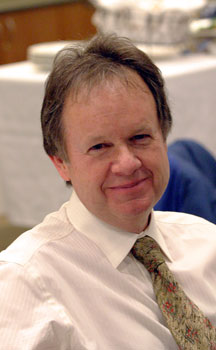

Friday - April 4, 2008
SLAC Today is
available online at:
http://today.slac.stanford.edu
In this issue:
From the Director of the Photon Science Directorate: Photon Science at SLAC–What, Why and Where to?
Reminder: Ice Cream on the Green
Word of the Week: Neutrino
Hugh Montgomery Named Jefferson Lab's New Director
Building the LCLS: Weekly Update
 |
 |
|
Friday - April 4, 2008 |
From the Director of the Photon Science Directorate: Photon Science at SLAC–What, Why and Where to? SLAC's outstanding reputation is built upon seminal scientific discovery, much of it enabled and facilitated by advanced accelerator-based tools for which SLAC has so often pioneered new ground. This is true in Particle Physics and Astrophysics. It is also true in the area we call photon science at SLAC—that is, the use of X-rays to study and understand the structure and behavior of matter down to the atomic scales of space and time, with relevance to fundamental scientific challenges, and important societal problems related to energy, the environment and human health. The roots of photon science at SLAC can be traced back to the founding of the Stanford Synchrotron Radiation Project in 1973, where a group of Stanford University faculty partnered with SLAC faculty and senior staff to conceive and create one of the first X-ray synchrotron user facilities in the world, parasitic on the SPEAR storage ring. Looking back, a key reason for success came from the intellectual leadership provided by faculty and scientific staff who developed new instrumentation, developed innovative new methodologies and analysis techniques, trained young scientists and rapidly engaged the outside academic and industrial user communities in what became a worldwide model for how to operate a synchrotron user facility. That beginning led to what we know of today as the Stanford Synchrotron Radiation Laboratory (SSRL) and from it came the Sub-Picosecond Pulse Source (SPPS) and the beginning of the Linac Coherent Light Source (LCLS). SSRL, with its integrated portfolio of photon science research, strongly helped catalyze the remarkable growth in synchrotron science worldwide that has now come to serve tens of thousands of users worldwide at dozens of synchrotron facilities. Read more... |
||
|
|
||
Reminder: Ice Cream on the Green
This Monday at 2:30 pm on SLAC's main lawn the BaBar collaboration will host a gathering to thank the PEP-II team and laboratory staff for a decade of data from the B-Factory. Persis Drell, Hassan Jawahery, David MacFarlane, Jonathan Dorfan and John Seeman will each speak briefly before refreshments are served. Join your colleagues and friends for free ice cream sundaes and snacks at this very special celebration of the people and the legacy of PEP-II. Word of the Week:
|
Hugh Montgomery Named Jefferson Lab's New DirectorHugh E. Montgomery, a highly regarded nuclear physicist with an extensive research portfolio and broad international experience, today was named director of the Department of Energy's Thomas Jefferson National Accelerator Facility. Montgomery's appointment as the lab's third director was announced by Jefferson Science Associates, LLC, which manages and operates Jefferson Lab for DOE. Montgomery, the associate director for research at the Fermi National Accelerator Laboratory since 2002, will begin his new duties at Jefferson Lab on Sept. 2. Fermilab, located in Batavia, Ill., also is a DOE research facility. Read full press release... Building the LCLS: Weekly UpdateConstruction highlights from the Linac Coherent Light Source (LCLS) this week include: - Beginning of installation of first equipment stands in the Beam Transport Hall. - Paving the fan out road where the south access road runs into the Research Yard next to the Beam Transport Hall. - Installing fire alarms in the Undulator Hall. - Preparations for the final concrete pour in the Far Experimental Hall and X-ray Tunnel.
|
Events
Access (see all)Announcements
|
| | ||
|
|
||
 <%
Response.AddHeader "Last-modified", getArticleDate()
'Response.AddHeader "Last-modified","Mon, 01 Sep 1997 01:03:33 GMT"
'Monday, December 06, 2010
%>
<%
Response.AddHeader "Last-modified", getArticleDate()
'Response.AddHeader "Last-modified","Mon, 01 Sep 1997 01:03:33 GMT"
'Monday, December 06, 2010
%>View online at http://today.slac.stanford.edu/. |
||